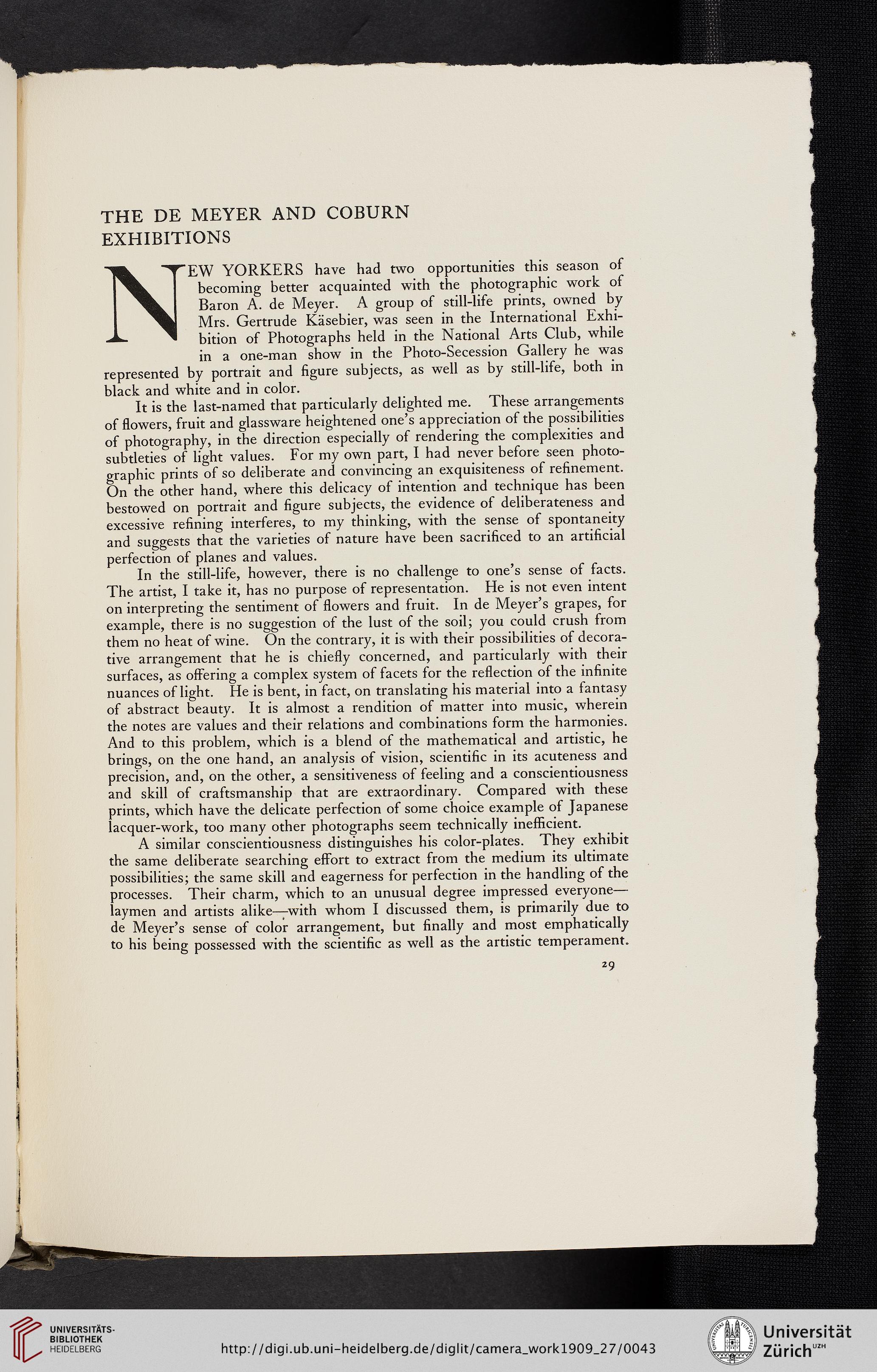Für diese Seite ist auch eine manuell angefertigte Transkription bzw. Edition verfügbar. Bitte wechseln Sie dafür zum Reiter "Transkription" oder "Edition".
THE DE MEYER AND COBURN
EXHIBITIONS
NEW YORKERS have had two opportunities this season of
becoming better acquainted with the photographic work of
Baron A. de Meyer. A group of still-life prints, owned by
Mrs. Gertrude Kasebier, was seen in the International Exhi-
bition of Photographs held in the National Arts Club, while
in a one-man show in the Photo-Secession Gallery he was
represented by portrait and figure subjects, as well as by still-life, both in
black and white and in color.
It is the last-named that particularly delighted me. These arrangements
of flowers, fruit and glassware heightened one’s appreciation of the possibilities
of photography, in the direction especially of rendering the complexities and
subtleties of light values. For my own part, I had never before seen photo-
graphic prints of so deliberate and convincing an exquisiteness of refinement.
On the other hand, where this delicacy of intention and technique has been
bestowed on portrait and figure subjects, the evidence of deliberateness and
excessive refining interferes, to my thinking, with the sense of spontaneity
and suggests that the varieties of nature have been sacrificed to an artificial
perfection of planes and values.
In the still-life, however, there is no challenge to one’s sense of facts.
The artist, I take it, has no purpose of representation. He is not even intent
on interpreting the sentiment of flowers and fruit. In de Meyer’s grapes, for
example, there is no suggestion of the lust of the soil; you could crush from
them no heat of wine. On the contrary, it is with their possibilities of decora-
tive arrangement that he is chiefly concerned, and particularly with their
surfaces, as offering a complex system of facets for the reflection of the infinite
nuances of light. He is bent, in fact, on translating his material into a fantasy
of abstract beauty. It is almost a rendition of matter into music, wherein
the notes are values and their relations and combinations form the harmonies.
And to this problem, which is a blend of the mathematical and artistic, he
brings, on the one hand, an analysis of vision, scientific in its acuteness and
precision, and, on the other, a sensitiveness of feeling and a conscientiousness
and skill of craftsmanship that are extraordinary. Compared with these
prints, which have the delicate perfection of some choice example of Japanese
lacquer-work, too many other photographs seem technically inefficient.
A similar conscientiousness distinguishes his color-plates. They exhibit
the same deliberate searching effort to extract from the medium its ultimate
possibilities; the same skill and eagerness for perfection in the handling of the
processes. Their charm, which to an unusual degree impressed everyone—
laymen and artists alike—with whom I discussed them, is primarily due to
de Meyer’s sense of color arrangement, but finally and most emphatically
to his being possessed with the scientific as well as the artistic temperament.
*
29
EXHIBITIONS
NEW YORKERS have had two opportunities this season of
becoming better acquainted with the photographic work of
Baron A. de Meyer. A group of still-life prints, owned by
Mrs. Gertrude Kasebier, was seen in the International Exhi-
bition of Photographs held in the National Arts Club, while
in a one-man show in the Photo-Secession Gallery he was
represented by portrait and figure subjects, as well as by still-life, both in
black and white and in color.
It is the last-named that particularly delighted me. These arrangements
of flowers, fruit and glassware heightened one’s appreciation of the possibilities
of photography, in the direction especially of rendering the complexities and
subtleties of light values. For my own part, I had never before seen photo-
graphic prints of so deliberate and convincing an exquisiteness of refinement.
On the other hand, where this delicacy of intention and technique has been
bestowed on portrait and figure subjects, the evidence of deliberateness and
excessive refining interferes, to my thinking, with the sense of spontaneity
and suggests that the varieties of nature have been sacrificed to an artificial
perfection of planes and values.
In the still-life, however, there is no challenge to one’s sense of facts.
The artist, I take it, has no purpose of representation. He is not even intent
on interpreting the sentiment of flowers and fruit. In de Meyer’s grapes, for
example, there is no suggestion of the lust of the soil; you could crush from
them no heat of wine. On the contrary, it is with their possibilities of decora-
tive arrangement that he is chiefly concerned, and particularly with their
surfaces, as offering a complex system of facets for the reflection of the infinite
nuances of light. He is bent, in fact, on translating his material into a fantasy
of abstract beauty. It is almost a rendition of matter into music, wherein
the notes are values and their relations and combinations form the harmonies.
And to this problem, which is a blend of the mathematical and artistic, he
brings, on the one hand, an analysis of vision, scientific in its acuteness and
precision, and, on the other, a sensitiveness of feeling and a conscientiousness
and skill of craftsmanship that are extraordinary. Compared with these
prints, which have the delicate perfection of some choice example of Japanese
lacquer-work, too many other photographs seem technically inefficient.
A similar conscientiousness distinguishes his color-plates. They exhibit
the same deliberate searching effort to extract from the medium its ultimate
possibilities; the same skill and eagerness for perfection in the handling of the
processes. Their charm, which to an unusual degree impressed everyone—
laymen and artists alike—with whom I discussed them, is primarily due to
de Meyer’s sense of color arrangement, but finally and most emphatically
to his being possessed with the scientific as well as the artistic temperament.
*
29


